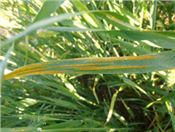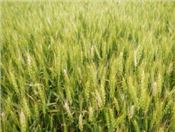Fungicides For Managing Fusarium Head Blight Of Wheat: How Late Is Too Late?
DR. CARL A. BRADLEY
PRINCETON, KY.
Much of the wheat crop in Kentucky has headed out and is flowering. Stripe rust (Figure 1) is now present in many Kentucky counties on susceptible varieties, and according to the Fusarium Head Blight Prediction Center, the current risk of Fusarium head blight (also known as “scab”) (Figure 2) is anywhere from low to high, depending on where you are in the state.
If fungicides are being considered for protection against Fusarium head blight, Caramba (BASF Corp.) and Prosaro (Bayer CropScience) fungicides have been shown in multi-year, multi-state university trials to be the most effective in reducing Fusarium head blight and the associated mycotoxin, deoxynivalenol (DON), which can contaminate harvested grain. The best time to apply a foliar fungicide for protection against Fusarium head blight is when wheat plants are beginning to flower (Feekes growth state 10.5.1). Many fields were at this stage last week, and some were sprayed prior to the rainfall that occurred recently. For those fields that were at the Feekes 10.5.1 growth stage late last week, but were not sprayed prior to the rainfall, an application of Caramba or Prosaro within the next few days may still provide effective protection against Fusarium head blight and DON contamination. A research study conducted between 2011 and 2013 by scientists at The Ohio State University and the University of Illinois showed that applications of either Caramba or Prosaro up to 6 days following Feekes growth stage 10.5.1 provided a similar level of control of Fusarium head blight and DON when compared to those fungicides applied at the Feekes 10.5.1 growth stage. ∆
DR. CARL A. BRADLEY: Extension Plant Pathologist, University of Kentucky

Figure 1. Stripe rust pustules on a wheat leaf.
Photos: Carl Bradley, UK

Figure 2. Symptoms of Fusarium head blight (“scab”) of wheat.